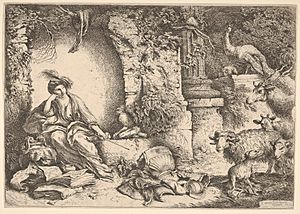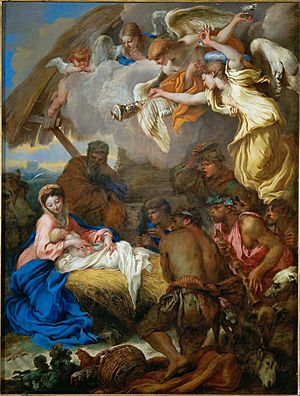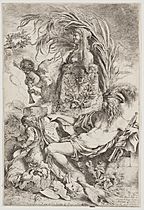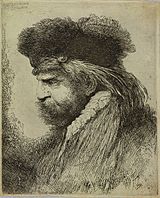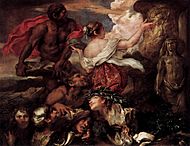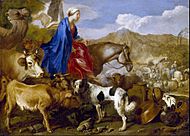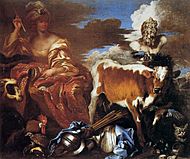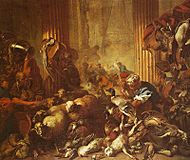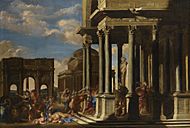Giovanni Benedetto Castiglione facts for kids
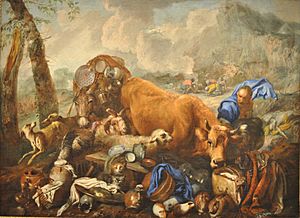
Quick facts for kids
Giovanni Benedetto Castiglione
|
|
|---|---|

Possible self-portrait, etching.
|
|
| Born | 1609 |
| Died | 1664 (aged 54–55) Mantua, Duchy of Mantua
|
| Known for | Painting and printmaking |
| Movement | Baroque |
Giovanni Benedetto Castiglione (born March 23, 1609 – died May 5, 1664) was an Italian Baroque artist. He was a talented painter, printmaker, and draftsman from the Genoa school.
He is best known today for his etchings. He also invented a special printmaking method called monotyping. People in Italy called him Il Grechetto, and in France, he was known as Le Benédette.
Castiglione painted many different things, including portraits, history paintings (pictures showing stories from history or myths), and landscapes. He became especially good at painting country scenes with more animals than people. He loved to paint scenes like Noah's ark with animals entering it. He also created new subjects from the early parts of the Old Testament, showing important figures with their animals.
Contents
Life of Castiglione
Giovanni Benedetto Castiglione was born in Genoa, a city in Italy. A writer named Raffaele Soprani, who wrote about Genoese painters, said that Castiglione's parents sent him to study with Giovanni Battista Paggi.
Art historian Rudolf Wittkower described Castiglione as a very keen student of Anthony van Dyck. Van Dyck arrived in Genoa in 1621. Castiglione also learned from Peter Paul Rubens, who had stayed in Genoa earlier in the 1600s. Rubens's paintings were easy to see in the city. Castiglione might have also trained with Bernardo Strozzi from Genoa.
Castiglione lived in Rome from 1634 to about 1645. After that, he went back to Genoa. He also traveled to other Italian cities like Florence and Naples. He returned to Rome in 1647. In 1651, he moved to Mantua to work as a court artist for Duke Carlo II and his wife Isabella Chiara de Austria. He passed away in Mantua.
Artistic Works
Castiglione was a brilliant draftsman, meaning he was very skilled at drawing. He was one of the first artists to make oil sketches (often using different art materials mixed together) as finished artworks. Before him, oil sketches were usually just quick studies for a bigger, final painting, like those done by Rubens. Castiglione often painted and etched the same subjects many times, but he always created new and different compositions.
He made about sixty etchings. An etching is a type of print where an artist draws on a metal plate with a special tool, then uses acid to create lines that hold ink. One of his most famous etchings is The Genius of Castiglione, which was published in 1648. Another important etching is Diogenes searching for a Man. Many of his etchings were about religious stories. His etchings are known for their amazing use of light and shadow, so much so that some people compared him to the famous artist Rembrandt. Castiglione likely saw Rembrandt's etchings by 1630.
Around 1648, Castiglione invented the monotype technique. This is the only printmaking method that was invented in Italy! He made over twenty monotypes in the years that followed. His most popular prints were a series of unique heads, often showing men with a somewhat Middle Eastern look, but also women. These prints were made in large numbers. Some of the subjects in his etchings include Diogenes with his lantern, Noah leading animals into Arc, St Joseph Asleep during Flight from Egypt, Circe surrounded by animals, Silenus at the fountain, Nativity, Resurrection of Lazarus, and The Genius of Castiglione.
Castiglione was famous for how well he could paint animals, especially farm animals. Animals were often the main focus in his paintings. For example, in his painting Jesus clearing the temple of Moneylenders, the religious event is a small part in the background. The stampede of animals is much more noticeable than the people. Castiglione's careful way of showing nature suggests he was influenced by artists like Scorza and the Flemish painter Jan Roos. Jan Roos, who lived in Genoa for a long time, was known for still life paintings and animal art. It's thought that Jan Roos might have encouraged Castiglione to add animals and still life elements to his religious and mythological artworks.
In Mantua, Castiglione earned the nickname "Grechetto." This name came from the classic, peaceful feeling of his country scenes. In his later years, he suffered a lot from a condition called gout. His brother, Salvatore, and his son, Francesco, also painted similar subjects. Because of this, many paintings thought to be by Benedetto might actually be copies of his work, or even original paintings by his son or brother. He also influenced another artist named Anton Maria Vassallo. Other artists like Giovanni Lorenzo Bertolotto, Anton Maria Zanetti, Michele l'Asne, Louis de Chatillon, and Coreneille Coemans made engravings based on his work.
You can find Castiglione's paintings in cities like Rome, Venice, Naples, Florence, and especially in Genoa and Mantua. His painting The Presepio (which shows the Nativity of Jesus) for the church of San Luca in Genoa is one of his most famous works. The Louvre museum has eight good examples of his art. He also painted SS. Mary Magdalene and Catharine for the church of the Madonna di Castello and St. James defeats the Moors for the Oratorio di San Giacomo della Marina, both in Genoa.
Gallery
-
Jacob leading the Flocks of Laban
See also
 In Spanish: Giovanni Benedetto Castiglione para niños
In Spanish: Giovanni Benedetto Castiglione para niños


